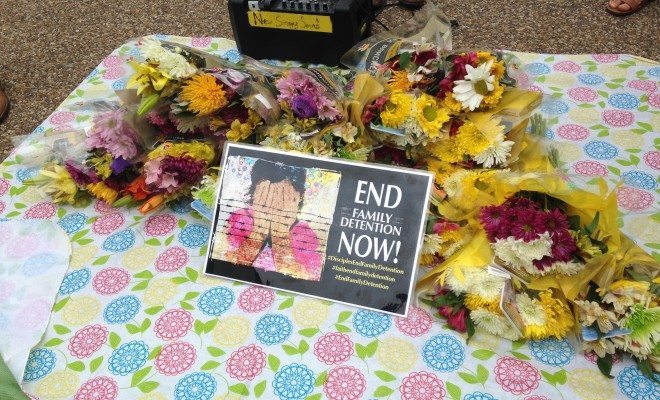 Image courtesy of [Alec Siegel for Law Street Media]
Image courtesy of [Alec Siegel for Law Street Media]
Society and Culture
Mother’s Day Appeal Outside the White House Aims to Abolish Family Detention Centers
On a dusty former oil-mining field in Dilley, Texas, enclosed by barbed wire fences and watched by guards day and night, hundreds of mothers and their children who are seeking asylum in America wait. They wait for a chance to plead their case to a judge. They wait for days, weeks, sometimes months. They wait for a future.
The South Texas Detention Complex is one of three such holding facilities–officially dubbed “family detention centers”–that hold undocumented immigrant families (mothers and children who are without a husband and father) while their asylum request is processed. Many come from Central America’s Northern Triangle: Guatemala, Honduras, and El Salvador. Some are fleeing gang violence, among the most lethal in the world. Others are escaping domestic abuse and oppressive governments.
But former detainees and advocacy groups are fighting to shut down these three family detention centers that continue to operate in the U.S. due to unlivable conditions and held an event to further their cause outside the White House this week. The other two facilities besides the one in Dilley are in Karnes City, Texas and Leesport, Pennsylvania. Advocates of closing the centers saw a boost last summer when a federal judge in Texas ruled the facilities as operating against the law.
Last week, however, the Texas Department of Family and Protective Services issued a temporary child care license for the Karnes County Residential Center, which can house 580 migrants at a time and is privately operated. This would allow Karnes to continue operating under the law by operating under the title of “child care facility.” A small victory for advocates against the license came yesterday when a judge in Texas ruled on behalf of Grassroots Leadership, an organization focused on ending for-profit incarceration, issuing a week-long restraining order on the child care license.
Though the number of illegal immigrants coming to the U.S. from Central America has dipped after a surge that peaked in the summer of 2014, 98 percent of Dilley’s 2,400 beds are filled with women and children from that region, according to Lindsay Harris, Legal Fellow at the American Immigration Council, or AIC.
“They are here because they’ve expressed a fear of returning back to their home country,” Harris said during an interview on Wednesday. There are six AIC members on the ground at the dirt plains of the Dilley complex, assisting asylum seekers through the legal process.
According to Harris, the legal process of seeking asylum is as follows:
Between 80 to 150 families each day are put through an informal interview with a member of the United States Citizenship and Immigration Services (USCIS), who rotate every two weeks between the three centers. The one to three hour interview is informal, and the families are allowed a legal representative (such as Harris), though many do not have one because of the deluge of daily interviews.
Those whose “credible fear” (the metric by which a migrant’s asylum request is judged: whether their situation back home is horrifying enough for them to stay in the U.S.) is rejected are subject to review by a judge. They are usually represented pro bono by a lawyer from an organization such as AIC.
Harris noted that most families do pass that stage and can further pursue their asylum claim, but are required to wear bulky ankle monitors and have weekly or monthly check-ins with immigration officers. She said rulings that don’t go the asylum seekers’ way aren’t always fair.
“These are survivors of trauma and torture, rape, incest, domestic violence,” she said. “Some of them have a very hard time articulating to a male asylum officer what they’ve been through.”
![Released mothers must wear these ankle monitors, which require frequent charging-and can't be removed. [Image courtesy of Jeff Pearcy via UUSC]](http://lawstreetmedia.com/wp-content/uploads/ankle-shackle-monitor-167x250.jpg)
Recently released mothers are monitored via these bulky ankle bracelets, which require frequent charging and can’t be removed. [Image courtesy of Jeff Pearcy via UUSC]
Ten of the women who were previously detained and able to convincingly articulate their need to stay in the U.S. came to the front step of the White House yesterday, many with their children, on a mother-to-mother mission to shut these facilities down.
The “Let Hope Bloom” event, held under a chilly gray sky at Lafayette Square just feet from the White House’s north gate, saw the mothers–all from Central America–handed certificates and a bouquet of lilies, daisies, and azaleas from the event’s sponsors, the Unitarian Universalist Service Committee (UUSC) and other religious and secular non-profit groups.
“The greatest gift we pray to give would be the ending of family detention,” Reverend Sharon Stanley-Rea of the religious group Disciples of Christ said at the event.
Giant Mother’s Day cards were signed by the mothers, their children and supporters, which were then delivered to two White House officials at the west gate. The cards were addressed to four mothers at the White House: First Lady Michelle Obama, Second Lady Dr. Jill Biden, Senior Advisor Valerie Jarrett, and Obama Assistant Cecilia Munoz.
![A mother signs a direct appeal to the most powerful mother in the White House: Michelle Obama. [Image courtesy of Alec Siege via Law Street Media]](http://lawstreetmedia.com/wp-content/uploads/IMG_3452-188x250.jpg)
A mother signs a direct appeal to the most powerful mother in the White House: Michelle Obama. [Image courtesy of Alec Siegel via Law Street Media]
One of the formerly detained mothers traveled from Alexandria, Virginia with her daughter to the White House.
“I’m happy [in America], it’s much better than being locked up,” she said in an interview with Law Street Media (through a translator), preferring her name be left out for privacy concerns. “When I was in detention I didn’t suffer physically but mentally it was really tough.”
She left her home in La Ceiba, Honduras to escape threats of extortion and was housed at the Karnes County Residential Center in Karnes City, Texas for 15 days before being released to pursue her claim of asylum and joining family members in Alexandria.
“I think my mom is very strong for the things that she’s gone through for me,” said her daughter, 15, also through a translator and requesting her name not be used for privacy concerns. “Coming to this country is not easy and I know that she did it for me.”
![This mother fled Honduras after threats of extortion with her daughter, now a 9th grade student in Alexandria, Virginia. [Image courtesy of Alec Siegel via Law Street Media]](http://lawstreetmedia.com/wp-content/uploads/IMG_3464-320x240.jpg)
This mother fled Honduras after threats of extortion with her daughter, now a 9th grade student in Alexandria, Virginia. [Image courtesy of Alec Siegel via Law Street Media]
Hannah Hafter, Senior Program Leader for Activism at UUSC, one of the sponsors at yesterday’s event, recently spent two weeks at the facility in Karnes and saw conditions unsuitable for children to spend any amount of time living in.
“There is no humane way in allowing children to grow up in detention,” she said in a phone interview with Law Street Media. She said babies are not allowed to crawl on the floors and that basic movement is restricted. She sees the centers as inherently flawed. “They can’t have enough toys, they can’t have enough classes to make [the centers] acceptable.”
An alternative method to family detention centers, according to Harris, would be to allow the asylum seekers to independently integrate into communities, with periodic check-ins with law enforcement, while they wait for their asylum request to be processed.
The Department of Homeland Security (DHS) opened a controversial family detention center in 2014 to accommodate the influx of families coming from Central America. The center, in Artesia, New Mexico, was closed in late 2014. The migrants who were being housed at the time were transferred to Dilley or Karnes.
Officials at U.S. Immigration and Customs Enforcement, the DHS branch that handles the family detention centers, did not respond to a request for comment at the time of publishing, and neither did representatives from Dilley or Karnes.
Last summer, Jeh Johnson, Secretary of DHS, released a statement supporting reforms to the detention centers, citing the increase in the facilities’ capacity as a response to an increase in illegal immigrants from Central America.
Harris, the legal fellow with AIC who spoke at the “Let It Bloom” event yesterday, noted that these facilities are a waste for every party involved: government resources, time, and taxpayer dollars. (She said it costs one thousand dollars to house a family of three).
“These are not criminals,” she said “They’re seeking protection and they should be given information and access to council, not put in detention.”
Editor’s Note: This post was updated on 5/6 to clarify the asylum process.








Comments